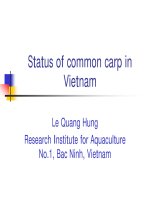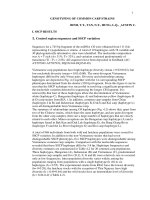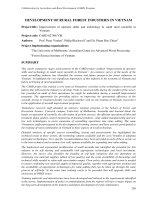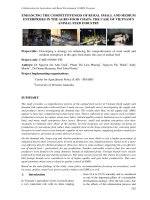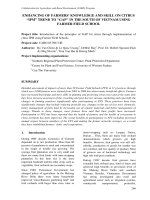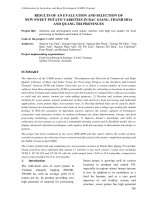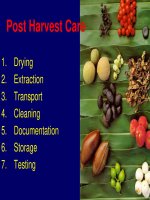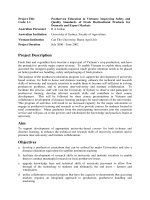Báo cáo nghiên cứu nông nghiệp " review of Common carp breeding program at RIA1-VN " docx
Bạn đang xem bản rút gọn của tài liệu. Xem và tải ngay bản đầy đủ của tài liệu tại đây (142.46 KB, 16 trang )
1
review of Common carp breeding program at RIA1-VN
Mr. Nguyen Huu Ninh, RIA1
Sumary
Common carp is one of the most important cultured species in Vietnam. The goal of the
carp breed program was creation of a common carp breed with stable genetic qualities
such as fast growth, high survival rate and attractive appearance.
In the first phase (1981-1985) the program focused on the assessment of the original carp
varieties, which should be used as initial materials for selection. In the second phase
(1986-1995) mass individual selection has been carried out among the three hybrid stocks
obtained by crossing among Vietnamese white carp, Hungarian scale carp and Indonesian
yellow carp. Despite the small size of the selected populations, the selection pressures for
the first five generations in an average were severity of selection 19.8%, intensity of
selection 1.52 and selection differential 93g.
The realized heritability (h
2
) of body weight determined for carp of one of the three
stocks was 0.29 in the first generation, 0.02 in the second generation, but this index
declined to around 0 in the fourth generation. The total genetic gain for body weight of
selected common carp after five generations was 33%.
Thus, it was recommended to move to family selection in the next phase (1996-2000) of
breeding program however its results were unexpected due to very low realized
heritability of almost 0.1 in second selected generation.
Continuing third phase breeding program of common carp is also presented in these
report which is undergoing at National Broodstocks Center, RIA1 by croosbreed between
6 carp populations in prospect to gain genetic variation from improved carp lines and
pure carp lines.
Background
According to the estimation of the Ministry of Fisheries (MOFI), the total fish production
of the country in 1998 was 1.67 million tonnes, of which around 538,000 tonnes came
from aquaculture (MOFI, 1998), providing nearly 35 % of the total animal protein intake
of the nation. The main cultured fish species in Vietnam are local and exotic carps
including common carp (Cyprinus carpio L), silver carp (Hypophthalmichthys harmandi
and H. molitrix), bighead carp (Aristichthys nobilis), mud carp (Cirihina molitorella),
2
grass carp (Ctenopharyngodon idella), black carp (Mylopharyngodon piceus), rohu
(Labeo rohita), mrigal (Cirrhinus mrigala), silver barb (Puntius gonionotus) and some
some species of Clarias, Pangasius and Tilapia (Oreochromis niloticus).
Aquaculture in Vietnam is facing with some problems, in the first instance should be
indicate the deterioration of economically important traits, decreased growth rate, small
maturation size, low survival and low disease resistance. Obviously, improvement of
genetic quality of cultured fish species is one of the most essential approaches to increase
aquaculture production.
Common carp is a traditional and important cultured species in Vietnam. Among eight
varieties of Vietnamese common carp white carp has been cultivated largely in many
areas of the Country (Trong, 1983). However, white carp like other local varieties
exhibited slow growth rate and early maturation. In 1970 and 1975 the mirror and scale
strains of Hungarian common carp were introduced to Vietnam. Indonesian yellow carp
was introduced to the South, Vietnam before 1975 and then transferred to the North in
1978. In the 70
s
the experiments on hybridization of the Vietnamese white carp with the
Hungarian carps have been carried out (Tuong and Thien, 1979; Thien and Tuong, 1983;
Thien, 1993). Hybrid carp (F1) showed fast growth and high survival. The best
productivity was obtained from raising hybrid carp. However, due to importer breeding
management, the base stocks of common carp in almost hatcheries over the country were
gradually losing their purity, thus decreasing the effectiveness of commercial crossing for
hybrids. Since 1981, research programs have focused on selection of common carp with
the intention of creating a fish breed with stable genetic qualities. In the first phase (1981-
1985) the program focused on the assessment of initial materials for selection. In the
second phase (1986-1995) mass individual selection has been carried out among the
hybrid stocks over six generations. Continued family selection were carried out over 2
generations in the period of 1996 to 2000.
Description of issue or practice
The materials for selection were preliminarily selected among 8 local and 5 exotic
varieties of common carp. They were Vietnamese white carp (V), Hungarian scale carp
(H) and Indonesian yellow carp (Y). To bring together a number of positive qualities
from these varieties and to improve the genetic variability of the initial materials for
selection, at first three stocks of single hybrids were obtained by crossing Vietnamese
carp with Hungarian carp (VH), Vietnamese carp with yellow carp (VY) and Hungarian
carp with yellow carp (HY). Then the males of each single hybrid are crossed with
3
females of the third variety. The double hybrids obtained in these crossings have been
evaluated and used as materials for further selection (Fig. 1).
Assessment of initial materials for selection was made by comparing some
morphological, physiological and biochemical characteristics among the above
mentioned pure common carp varieties and their hybrids.
In order to carry out mass individual selection about 5-10 families (one family included 1
female and 3-4 males) of each stock were bred at the same day. Their eggs were
incubated under the same conditions. The rearing of fry and fingerlings and culturing
them to marketable size were done under similar environmental conditions. On an
average, about 20% of total number marketable fish in each stock were selected based on
the body weight and appearance (big body and small head). The selection effectiveness
was estimated according to Falconer (1960).
R= Sh
2
= iδh
2
R: effectiveness of selection i: intensive of selection
S: selection differential δ: average square variation
h
2
: heritability of the trait (body weight)
To estimate the coefficient of realized heritability of fish body weight in each selected
generation, the experiments were implemented according to the schema in figure 2.
Before mass selection of marketable fish was done, a randomly collected control
population was kept. Then another group was collected by selecting for big body weight
(experimental group). Deduction of the average body weight between experimental group
and control group was a selection differential (S). In the next year the offsprings of the
two groups were obtained by the same method and the fingerlings of control
experimental groups were reared by communal stocking in the same pond to a marketable
size. The deduction of the average body weight between two offspring groups had to be
the effectiveness of selection for one generation (R). The heritability was calculated
according to formula:
R p1 –p0
H= =
S P1-Po
4
Vietnamese (white)
Common carp
Hungarian (scale)
Common carp
(Indonesian) Yellow
Common carp
H
V
Y
HY
V
Y
V
H
Χ V x Ξ (HY)
Χ
H x
Ξ
(VY)
Χ
Y x Ξ (VH)
V(
HY
)
H
(V
Y
)
Y
(V
H
)
F1
(Double)
1986
MASS LELECTION
V(
HY
)
H
(V
Y
)
Y
(V
H
)
F2
1988
MASS LELECTION
V(
HY
)
H
(V
Y
)
Y
(V
H
)
F3
1989
MASS LELECTION
V(
HY
)
H
(V
Y
)
Y
(V
H
)
F4
1991
MASS LELECTION
V(
HY
)
H
(V
Y
)
Y
(V
H
)
F5
1993
MASS LELECTION
V(
HY
)
H
(V
Y
)
Y
(V
H
)
F6
1995
F1 (Single)
Fig. 1- Mass selection of Hybrid Common carp
5
Research and development
Morphological characterization of common carp varieties and their hybrids
There are 8 local and 3 introduced varieties of common carp in Vietnam. The local
varieties, identified on basic of morphology and coloration, are white scaled, Bac Can,
Ho Tay, South Hai Van, Red, Violet, High Body Depth and Scattered Scale varieties
(Trong, 1983). The introduced common carps are Hungarian scaled, Hungarian mirror
and Indonesian yellow varieties.
Crossing between Hungarian carp and Vietnamese carp, Hungarian carp and Indonesian
carp, Vietnamese carp and Indonesian carp was carried out in the 1980’s for investigation
of their hybrid growth performance. Morphological study on Vietnamese, Hungarian,
Indonesian and hybrid common carps (Table 1) was also conducted by Research
Institutes for Aquaculture No.1 and the University of Hanoi in the same period (Thien
and Tuong, 1983; Thien 1990).
Table 1. Morphology and morphometrics of common carp varieties and their hybrids
(H = Hungarian; Y = Indonesian Yellow; V = Vietnamese White).
Varieties Hybrids Descriptions
H Y V H x V H x Y V x Y
Body weight (g)
Standard length (Cm)
24.3 ± 1.41
8.2 ± 0.16
22.2 ± 1.27
8.3 ± 0.18
16.3 ± 0.61
7.9 ± 0.09
21.2 ± 0.91
8.1± 0.11
22.8± 1.21
8.2 ± 0.15
12.9 ± 0.89
6.9 ± 0.15
As % of standard length:
Maximal body height
Minimal body height
Length of head
Dorsal spine to tip most
dorsal ray (DSR)
Intestine length
As % of head length:
Diameter of eye
Length of barbell
38.1 ± 0.19
14.3 ± 0.13
34.1 ± 0.24
36.3 ± 0.24
174.0 ± 1.6
26.6 ± 0.32
17.8 ± 0.29
35.1 ± 0.32
13.0 ± 0.13
31.9 ± 0.13
36.6 ± 0.25
185.7± 1.8
24.0 ± 0.37
18.6 ± 0.25
30.9 ± 0.25
11.9 ± 0.10
31.6 ± 0.16
33.5 ± 0.16
145.0 ± 1.3
29.6 ± 0.49
18.0 ± 0.21
35.5 ± 0.25
14.5 ± 0.16
34.4 ± 0.38
36.6 ± 0.38
175 ± 1.4
25.9 ± 0.45
19.2 ± 0.21
37.3±
0.28
13.9± 0.17
33.1± 0.30
34.4± 0.14
186 ±2.2
25.4± 0.3
18.2± 0.26
32.2 ± 0.30
14.4 ± 0.17
32.1 ± 0.40
37.1 ± 0.30
165.8 ± 2.1
27.9 ± 0.50
17.4 ± 0.30
6
No. of lateral line scales
No. of Dorsal rays
No. of Anal rays
No. of branched stamens in
first bow
No. of vertebrae
37.7 ± 0.20
18.9 ± 0.12
5
24.9 ± 0.20
35.8 ± 0.12
32.9 ± 0.25
18.3 ± 0.16
5
19.7 ± 0.17
35.1 ± 0.08
32.0 ± 0.14
20.4 ± 0.16
5
20.7 ± 0.18
34.1 ± 0.08
32.6 ± 0.12
18.0 ± 0.08
5
20.2 ± 0.20
34.4 ± 0.13
33.8± 0.16
18.2± 0.26
5
22.7± 0.23
35.0± 0.16
33.4 ± 0.15
19.0 ± 0.15
5
20.2 ± 0.18
34.7 ± 0.20
Genetic characterization of common carp populations
Transferrin of pure common carp varieties and their hybrids was analysed using 12 %
starch gel electrophoresis. Four banding patterns were observed, designated as A,B,C and
D, with 8 different phenotypes (Thien and Tuong, 1983: Thien 1990) (Table 2).
Table 2. Distribution (%) of Transferrin phenotypes in different common carp varieties
(HS = Hungarian scaled; HM = Hungarian mirror; Y = Indonesian yellow; V =
Vietnamese white; HS x V = hybrid Hungarian x Vietnamese).
Carp
varieties
n AA AB AC BB BC BD CC DD
HS
HM
Y
V
HS x V
58
9
33
28
33
1.72
11.1
3.58
3.02
-
-
88.9
9.1
-
-
74.14
-
39.39
92.84
93.96
1.72
-
12.12
-
-
13.8
-
27.27
3.58
-
5.17
-
-
-
3.02
1.72
-
12.12
-
-
1.72
-
-
-
-
Two banding patterns of serum esterase were obtained, designated as F (fast) and S
(slow). There were three esterase phenotypes in pure varieties and their hybrids (Table 3).
Two banding patterns with two phenotypes of pre-albumin were observed in pure and
hybrid common carp varieties (Table 4). Serum proteins were also analysed in these
strains and the H x V crossbred (Table 5).
Table 3. Distribution (%) of esterase phenotypes in different common carp varieties (HS
= Hungarian scaled; HM = Hungarian mirror; Y = Indonesian yellow; V = Vietnamese
white; HxV = hybrid Hungarian x Vietnamese).
Carp varieties N FF FS SS
HS 58 81.03 18.97 -
7
HM
Y
V
H x V
9
33
28
33
100.0
-
28.58
42.42
-
100
71.42
42.42
-
-
-
3.03
Table 4. Distribution (%) of pre-albumin phenotypes in different common carp varieties
(HS = Hungarian scaled; HM = Hungarian mirror; Y = Indonesian yellow; V =
Vietnamese white; HxV = hybrid Hungarian x Vietnamese).
Carp varieties N FS SS
HS
HM
Y
V
H x V
58
9
33
28
33
8.64
-
12.12
3.58
9.09
91.36
100.0
87.88
96.42
90.91
Table 5. Serum protein of various common carp varieties (HS = Hungarian scaled; HM =
Hungarian mirror; Y = Indonesian yellow; V = Vietnamese white; H x V = hybrid
Hungarian x Vietnamese).
Varieties Total protein
(g%)
Albumin
(g%)
α-globulin
(g%)
β-globulin
(g%)
δ-globulin (%)
V
HS
HM
Y
H x V
2.60 ± 0.041
3.03 ± 0.044
3.06 ± 0.033
3.51 ± 0.033
2.84 ± 0.022
0.85 ± 0.034
1.05 ± 0.066
1.06 ± 0.072
1.18 ± 0.048
0.90 ± 0.034
0.63 ± 0.036
0.69 ± 0.029
0.70 ± 0.025
0.84 ± 0.039
0.71 ± 0.026
0.56 ± 0.036
0.63 ± 0.029
0.68 ± 0.036
0.75 ± 0.033
0.64 ± 0.022
0.56 ± 0.041
0.66 ± 0.04
0.62 ± 0.033
0.74 ± 0.033
0.59 ± 0.022
Heterosis in intraspecific crossbreeds of common carp
Eight varieties of local common carp were investigated, of which white carp, a variety
with high viability is the most popular (Trong 1983). However, this carp and other
varieties of Vietnamese common carp presented slow growth and early maturity.
Attempts aimed at obtaining heterosis by crossing among these varieties were not
successful.
8
Two Hungarian common carp strains (mirror and scale carps) were introduced in
Vietnam in 1970 and 1975 respectively. Under Vietnamese conditions, the Hungarian
carps showed fast growth and late maturation but were easily infected with diseases and
possessed low viability. The first hybrid generation (F1) crossing between Vietnamese
white carp and Hungarian carp showed the best characteristics from their parents i.e. high
survival rate, fast growth and attractive appearance. The survival rate of hybrid fry and
fingerling was much higher than that of Hungarian carp (Table 6). At the same time
survival rate of the hybrids and Vietnamese carp was similar.
Table 6. Survival rate (%) of fry and fingerling of Vietnamese common carp (V),
Hungarian common carp and their reciprocal hybrids (VH, HV).
Survival rate (%) Stage Crossing
1974 1975 1976
Fry
V
VH
HV
H
51.6
61.6
60.4
22.3
-
70.0
44.3
40.0
71.2
80.0
78.0
37.6
Fingerling
V
VH
HV
H
85.9 ± 9.4
94.9 ± 1.9
81.4 ± 7.5
45.7 ± 5.2
-
76.2 ± 2.9
76.7 ± 2.3
38.6 ± 2.4
78.3 ± 0.2
90.0 ± 3.3
73.0 ± 11.3
46.3 ± 5.1
Mass selection of common carp
The data collected during process of mass selection showed that the number of
experimental fish in each stock was limited due to a limited number of ponds. Even
though the scale of selection is small (Table 8) the indices obtained proved to be
acceptable.
Thus in first generation the number of fish obtained for mass selection in one of stocks
was 1720, in each of two other stocks was 400 where as in second generation the number
of fish in each stock was only 250 but the selection differential in second generation was
even higher than that in F1. In the F3 generation field trials, due to poaching of some
stocked fishes the total number of fish obtained for selection was reduced. So around
33% of fishes in each stock was selected. It led to declining of the selection intensity and
the selection differential. In the next generations following the recommendation of some
9
geneticist-selectionists (Kirpichnikov, 1987) about 20% of fishes was kept to established
the broodstocks. As a result the selection indices were stabilized in an acceptable level.
After five selected generations the common carps of all three stocks have been clearly
improved in growth rate and appearance. However, in order to estimate the genetic gain it
was necessary to know the coefficient of heritability. The data obtained in the
experiments to determining the realized heritability of body weight showed that the
indices in the first two generations were suitable for individual selection, but they were
decreased from F1 to F4 generation.
In F1 generation the realized heritability was 0.29. In F2 generation experiments, the
results were analyzed and adjusted according to the methodology of Wohlfath and Moav
(1972), because of the difference in body weight between two groups of fingerling when
stocked (Table 9).
The realized heritability of body weight was 0.20 for the F2 generation. In the F4
generation this index was declined even to around 0. In fact, the effectiveness of
individual selection of common carp in the last two generations was low. The experiment
of comparison of growth rate of carps obtained from breeders in F3 and F5 selected
generation (Table 10) showed that the difference in body weight was 7% only. It is
expected that improvement of selection effectiveness in the next phase of the breeding
program should be done by applying another method, for example, family selection.
An average coefficient of realized heritability calculated for each generation was 0.16.
So, based on average index of selection differential, the response to selection for
increasing body weight in each generation could be estimated and it should be around
15g or 6.6%. So, the total genetic gain for body weight in the common carp breeding
program after 5 selected generations was 33%.
Decrease of the genetic gain could be caused by inbreeding. To avoid the inbred
depression it was recommended to cross among the three stocks to producing hybrid seed
for grow-out farmers. Preliminary data obtained in the experiments following this
direction (Table 11) showed that the heterosis effect has found out in both experiments
but it was more significant in the experiment No.2.
Decline of realized heritability in these selection program might be caused by reducing in
variability of selected trait. With intention of understanding the genetic structure of the
selected common carp stocks in 5
th
generation, some isozymes namely Lactat
dehydrogenase (LDH), Malat dehydrogenase (MDH), Aspartat aminotransferase (AAT)
and Esterase (EST) located in blood, heart, liver and muscle of the fishes were studied by
electrophoresis in 6% polyacrylamide gel. All the above mentioned isozymes were
10
polymorphic and the electrophoregrams included from 2 to 6 bands. The data on
comparison of three stocks showed that LDH in muscle, heart and liver, MDH in liver
and muscle, as well as AAT in blood, heart and muscle of the carps in all the stocks were
identical. The electrophoretic patterns of AAT in liver, EST in heart and muscle were
also similar but there were some differences between the stocks in frequency of the
bands. Identification of the fish stocks could be done only by using parallel analysis of
LDH, MDH and EST in blood.
For the fishes in each stocks the identity of above mentioned isozymes was in very high
level. Thus, genetic variability of the fishes within the stocks after 4-5 generations has
been possibly declined.
Table 7. Presentative data of the mass individual selection of the hybrid stocks of
common carp (V-Vietnamese, H-Hungarian and Y-Indonesian Yellow common carp)
Year Stocks Total Body Indices collected through selection
generation
and place
No. of
fish
weight
(g)
Severity
V (%)
Intensity i
(S/δ )
Differenti
al S (g)
1986
F1
RIA.1
H x (YxV)
V x (YxH)
Y x (HxV)
400
400
1720
162±6
178±4
187±8
12.5
12.5
7.5
2.77
1.66
1.94
99
84
82
1988
F2
RIA.1
H x (YxV)
V x (YxH)
Y x (HxV)
248
258
253
152±7
104±5
148±9
10.1
9.7
9.9
1.76
2.03
1.60
117
177
164
1989
F3
RIA.1
H x (YxV)
V x (YxH)
Y x (HxV)
75
243
74
149±8
155±12
310±16
33.3
32.9
33.8
1.25
0.80
0.77
52
62
41
1991
F4
RIA.1
H x (YxV)
V x (YxH)
Y x (HxV)
200
209
189
260±6
197±5
299±6
20.0
19.1
25.9
1.26
1.75
1.24
74
124
47
1992
F5
RIA.1
H x (YxV)
V x (YxH)
Y x (HxV)
229
235
175
314±12
300±9
350±10
21.8
21.3
22.0
1.28
1.72
1.72
97
69
93
1993
F5
H x (YxV)
V x (YxH)
257
263
226±10
300±14
19.5
20.9
1.39
1.06
85
101
11
RIA.1 Y x (HxV) 243 318±11 22.6 1.44 114
1995
F6
all stocks Brooders
Average for 5 generations 228 19.8 1.52 93
Table 8. Heritability (h
2
) of the body weight of hybrid common carp Hungarian x
(Vietnamese x Yellow)
Generation Parent's body weight (g) Offspring's body weight (g) Heritability
Control
Stock
Selected
Stock
Control
Stock
Selected
Stock
h
2
=R/S
F1
F2
162±6
218±10
261±9
312±21
180±4
316
209±6
335
+ 0.29
+ 0.20
1
F4
2
246±5
246±5
334±9
334±9
264
288±7
268
282±5
+0.05
-0.07
Table 9. Adjusted average body weight of the common carp in the experiment on
determination of realized heritability in 1988
Group of fish Stocking weight (g) Harvesting weight (g) Weight after adjustment (g)
Experiment 71±4 365±9 335
Control 51±3 286±9 316
Table 10. Growth rate of common carp of the F
3
and F
5
selected generations in a grow-
out pond; Stock [Hungarian x (Vietnamese x Yellow)]-Communal stocking - 1995
Generation 6 July
1995
Stocking
18 Aug.
1995
average
5 Oct.
1995
average
16 Nov.
1995
average
14 Dec.
1995
average
9 Feb. 1996
weight
(g)
weight
(g)
weight
(g)
weight
(g)
weight
(g)
Average
(g)
%
F5 15.7 60 170±4 264±7 317±6 409±10 107
F3 15.7 60 170±8 232±7 305±9 382±9 100
12
Table 11. Body weight of common carp in pure stocks and their hybrids reared in the
same pond, 1995
No.
Experiment
Stocks and
their hybrids
Stocking
weight (g)
Harvesting
weight (g)
Heterosis effect
g %
H x (VY) 20 365±10 + 21 5.8
1 Y x (HV) 20 377±10 + 9 2.4
Hybrid 19 386±12
H x (VY) 16 367±12 + 127 34.6
2 Y x (HV) 17 415±10 + 79 19.0
Hybrid 17 494±15
Family selection of common carp
Family selection of common carp has been conducted at RIA-1 since 1998, with the main
objective to select a common carp line with fast growth and high survival to improve its
production in aquaculture. Using the 5
th
generation of common carp from mass selection
as the initial materials, the programme has succeeded in producing two new generations
through induced breeding and rearing of juvenile in hapas. The first generation, with
about 375 brood fish, were selected from the 5 best families (out of 24). Following up the
breeding workplan for the second generation, induced breeding was undertaken
successfully with 40 families of the selected generation and 23 pairs of the base
population. Rearing of juveniles has been carried out entirely in hapas. After harvest,
2000 fingerlings of the second generation were reared to marketable size for further
selection. In the middle of 2001, fish in the growout pond were harvested for estimation
of genetic parameters. Based on breeding value (A), 400 fish (200 females and 200
males) were selected as brood stock for the third generation of selection.
Family selection of common carp has been conducted for three years (1998-2000).
Following up the selection plan, the programme has succeeded in selection of the first
generation and from then the second generation have been produced. Selection of
individuals and families in the second generation was undertaken when the size of fish in
growout ponds reached marketable size.
In order to assess the result of selection after two selected generations, the realized
heritability of body weight (h
2
) at the second selected generation need to be determined.
13
It is ensured that the h
2
index can be computed until the present experiment fish in
growout ponds reached around 1,000 g.
However, it was considered that further family selection of common carp at RIA-1
depends on genetic gain. If the realized heritability (in second generation) was over 0.1,
the selection programme could be continued. These index indicated over 5 % of faster
growth of fish obtained in each selected generation.
Combination of family and individual selection of common carp
Six common carp (Cyprinus carpio L.) lines using as materials in these breeding program
are 2
nd
generation of family selection (1), Hungarian 6
th
generation of mass selection (2),
Yellow 6
th
generation of mass selection (3), Vietamese 6
th
generation of mass selection
(4), Hungarian scale carp (5), Indonesian yellow carp (6). The broodfish was 2-3 years
old with mean body weight of 1.5-3.0kg. All the spawners were healthy, free from
disease and deformity.
In Mach and early April 2004, full maturity of brooders were selected for production of
families through artificial spawning. The brood fish were injected twice doses of
hormone (LRH-a) in an interval of 5 hrs. After the second injection about 8-10 hrs.
releasing of eggs started and stripping was done immediately for each family.
Fertilization of eggs was followed by dry method. After washing adhesive, the eggs of
each family were incubated separately in the jars of 10L volume. At 18.5-20
o
C of water
temperature, hatching took place after 48-50 hrs. Due to limited facilities and un-
consolidate maturation of brooder, 101 families were produced in 3 batches of which 12,
38, 51 families were in 1
st
, 2
nd
and 3
rd
respectively with 22 days longest distant between
1
st
and 3
nd
batch. All male and female spawners produced 101 families were marked by
PIT tags (AVID Microchip) to identify the individuals and family number.
After hatching, the larvae were gathered in the fine mesh size hapas for nursing. Within 3
days, the larvae completed yolk absorption; swim-up fry were fed with artificial food for
2 days before they were transferred to the rearing facility. Rearing of swim-up fry to the
size of 0.5-1.0g was conducted in hapas. Swim-up fry of each family were stocked in 1
m
3
hapas with the stocking density was 1,000fry/hapa. The fry were fed daily with the
pelleted feed containing 40% crude protein at a rate of 10% body weight. Rearing period
was 2 months (April-May).
Fingerlings of each family were reared in 5.0 m
3
hapas, 500 fry stocked in a hapa. The fry
were fed daily with pelleted feed (30% crude protein) at 7% body weight. Rearing period
lasted from May to June.
14
It was known that common carp could not growth well in hapas condition because of its
habitat so experiment designed to culture in pond by position tagging using Code Wide
Tag (CWT). Application of CWT for fingerlings could stock 5 families in the same pond
when it marks 5 different position on tail, abdomance, back, left and right chick.
The growout stage for marked CWT fish were conducted in earthen pond by devided into
units of 120m
2
area for each of 500 individuals for 5 families. Fish had grown in pond
from June to August and reached 100-150g. At those time, some families were loss
because of low survival rate. Other families were removed when fish appeared variety
morphology as yellow color, no scale which are not prefered by consumer in Vietnam.
Position marked families were screened by CWT scaner. In primary, the breeding
experiment designed to produce 101 families by crossdreed between 6 lines of common
carp available at National Broodstock Center of Northern Vietnam. As result, there have
been 86 families available for Pit Tag application of 35fish/families. More than 3000fish
have been injected Pit Tag and stocked communally in 2 ponds at the density of 1 fish per
1m
2
from August up to now. Average fish weight is almost 350g/fish in recently.
Figure 2. Crossbreeding between carp lines to produce 86 families
Maternal parent
Paternal
parent
Family
selection,
2
nd
gener.
Hungarian
6
th
gener.
H(VY)
Hungaria
n scale
carp
Yellow
6
th
gener.
Y(VH)
Indonesia
n Yellow
Vietnamese
line 6
th
gener. mass
selection
Family
selection,
2
nd
gener.
8
9
7
5
1
3
Hungarian
6
th
gener.
H(VY)
9
7
4
1
2
Hungarian
scale carp
6
4
4
-
Yellow 6
th
gener.
Y(VH)
5
3
3
Indonesian
Yellow
3
3
Vietnamese
line 6
th
gener. mass
selection
2
15
- Plan to collect data and analysis in June 2005
+ Body weight was measured by using electronic balance with 0.01 g sensitive
+ Regression analysis was used to determined the correlation between survival
and growth rate of fish in rearing stage
+ One way ANOVA was used to determine growth difference between families.
+ Means for individual final weight was compared using Least Significant
Differences (LSD). Differences at P<0.05 level were considered significant.
Percentage data were arcsine-transformed prior to analysis.
- Selection of family
The best families were selected based on the spawning performance, viability of
juvenile and growth rate of adult fish.
- Selection of individuals
Intensity of selection was 20% of the best individuals with sexual ratio (male:
female) was 1:1.
Conclusion
1. The long term breeding program of common carp has been carried out in Vietnam
with the goal to increase growth rate and attractive appearance of the fish. After
generations of individual selection the body weight of marketable fish has been
increased 33%.
2. Heritability of family selection has gradually reduced to very low (0.1) in second
selected generation.
3. To continue the breeding program in the next phase combination of family and
individual selection is undergoing with very realizable genetic gain when using
variety genetic materials of hybrid carp lines and pure carp lines.
4. It is expected that the best way to disseminate improved common carp seed to the
farmers should be supplying the hybrids obtained by crossing among three stocks.
16
References
Dan, N.C., Thien, T.M., Tu, H.D., 2000. Family Selection of Common Carp (Cyprinus
carpio L.) in Northern Vietnam. Paper is presented at the “Final meeting of Genetic
Improvement of Carp Species in Asia” held in Wuxi, China.
Falconer, D.S., 1960. Introduction to quantitative genetics. Edinburgh-London, 365p.
Kirpichnikov, V.S., 1987. Genetics and selection of fishes. Leningrad, 520p (in Russian).
Thien, T.M. and Tuong, P.M., 1983. Commercial hybridization of some pond fishes in
Vietnam. In: Biotechnology in Freshwater Fish Culture. Hanoi, pp. 7-30 (in Vietnamese).
Thien, T.M., 1993. A review of the fish breeding research and practices in Vietnam. In:
Selective Breeding of Fishes in Asia and the United States-Proceedings of a Workshop in
Hololulu. Hawaii, May 3-7.
Thien, T.M., 1996. Carp breeding in Vietnam 1980-1996. Final Scientific Report, 15p.
Trong, T.D., 1993. Research on variability of morphology of common carp (Cyprinus
carpio L) in Vietnam. PhD thesis. Hanoi, 38p (in Vietnamese).
Tuong, P.M. and Thien, T.M., 1979. Commercial Hybridization of common carp. Hanoi,
70p (in Vietnamese).
Wohlfarth, G. and Moav, R., 1972. The regression of weight gain on initial weight in
carp. Aquaculture No.1, pp.7-28.


